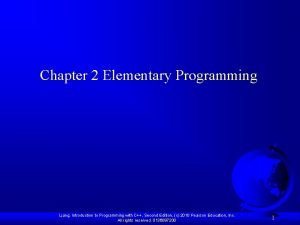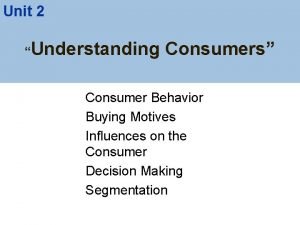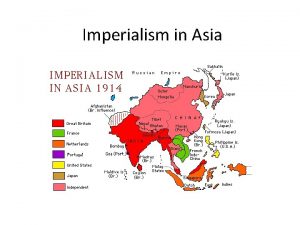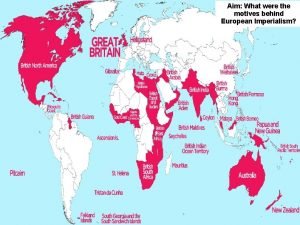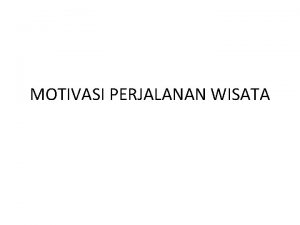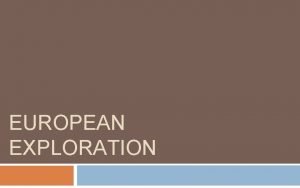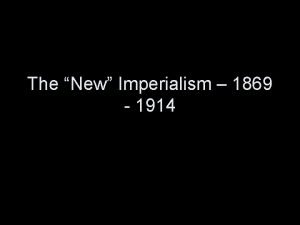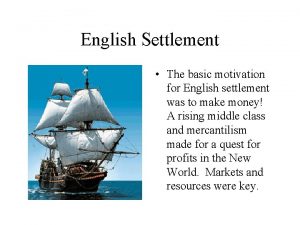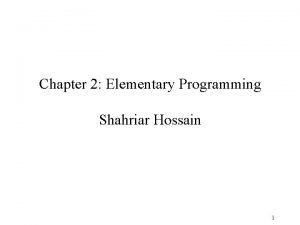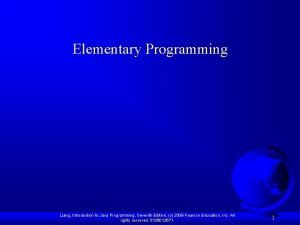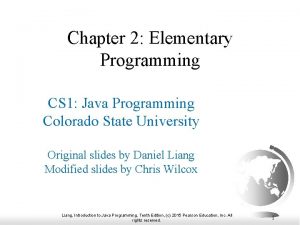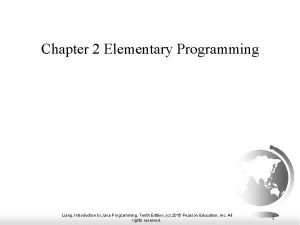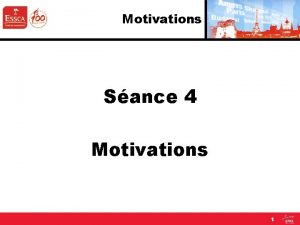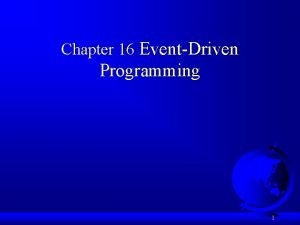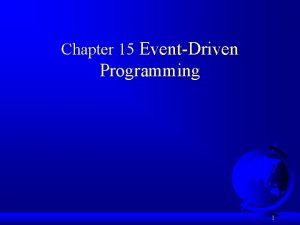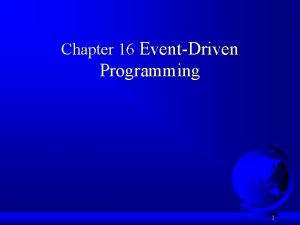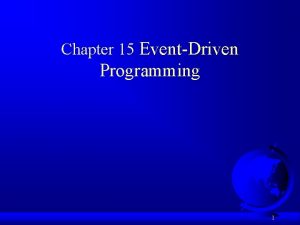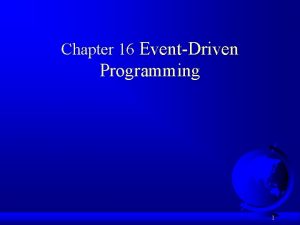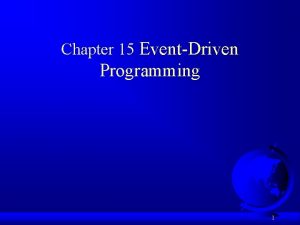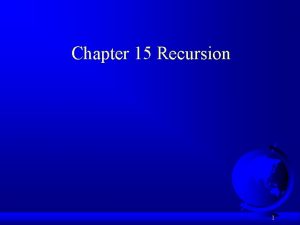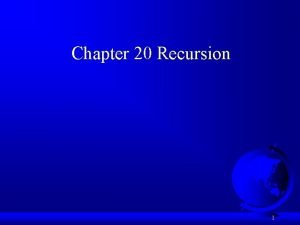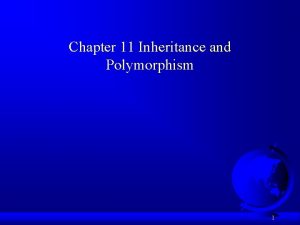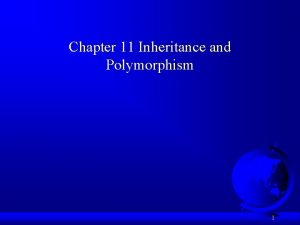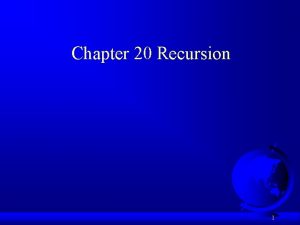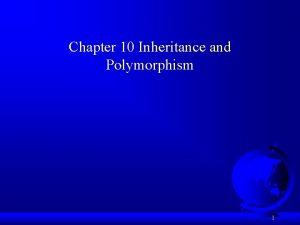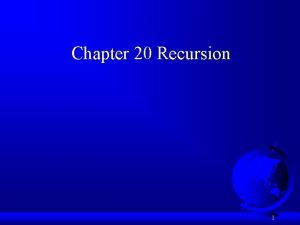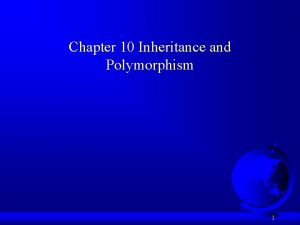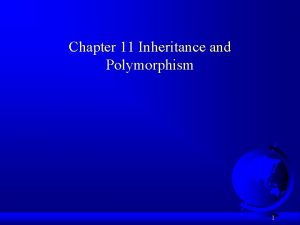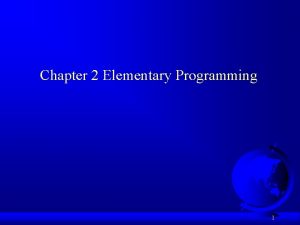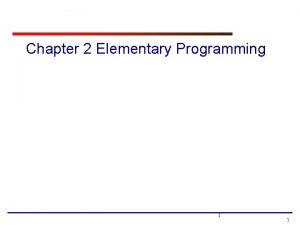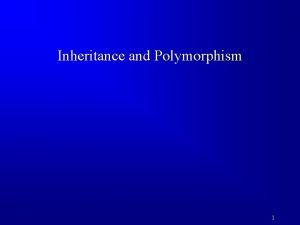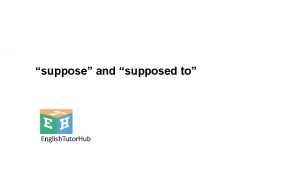Chapter 2 Elementary Programming 1 Motivations Suppose for








































- Slides: 40

Chapter 2 Elementary Programming 1

Motivations Suppose, for example, that you need to take out a student loan. Given the loan amount, loan term, and annual interest rate, can you write a program to compute the monthly payment and total payment? This chapter shows you how to write programs like this. Along the way, you learn the basic steps that go into analyzing a problem, designing a solution, and implementing the solution by creating a program. 2

Objectives F F F To write programs that perform simple computations (§ 2. 2). To obtain input from a program’s user by using the input function (§ 2. 3). To use identifiers to name variables (§ 2. 4). To assign data to variables (§ 2. 5). To define named constants (§ 2. 6). To use the operators +, -, *, /, //, %, and ** (§ 2. 7). To write and evaluate numeric expressions (§ 2. 8). To use augmented assignment operators to simplify coding (§ 2. 9). To perform numeric type conversion and rounding with the int and round functions (§ 2. 10). To obtain the current system time by using time() (§ 2. 11). To describe the software development process and apply it to develop the loan payment program (§ 2. 12). To compute and display the distance between two points (§ 2. 13). 3

Introducing Programming with an Example Listing 2. 1 Computing the Area of a Circle This program computes the area of the circle. IMPORTANT NOTE: Compute. Area Run (1) To enable the buttons, you must download the entire slide file slide. zip and unzip the files into a directory (e. g. , c: slide). (2) You must have installed Python and set python bin directory in the environment path. (3) If you are using Office 2010, check Power. Point 2010. doc located in the same folder with this ppt file. 4

animation Trace a Program Execution # Assign a radius = 20 # radius is now 20 # Compute area = radius * 3. 14159 # Display results print("The area for the circle of radius " + Assign 20 to radius 20 str(radius) + " is " + str(area)) 5

animation Trace a Program Execution # Assign a radius = 20 # radius is now 20 # Compute area = radius * 3. 14159 # Display results print("The area for the circle of radius“, Assign result to area radius area 20 1256. 636 radius, " is "area) 6

animation Trace a Program Execution # Assign a radius = 20 # radius is now 20 # Compute area = radius * 3. 14159 # Display results print("The area for the circle of radius", print a message to the console radius area 20 1256. 636 radius, "is", area) 7

Reading Input from the Console 1. Use the input function variable = input("Enter a string: ") 2. Use the eval function var = eval(string. Variable) eval("51 + (54 * (3 + 2))") returns 321. Compute. Area. With. Console. Input Run Compute. Average Run 8

Identifiers F An identifier is a sequence of characters that consists of letters, digits, underscores (_), and asterisk (*). F An identifier must start with a letter or an underscore. It cannot start with a digit. F An identifier cannot be a reserved word. (See Appendix A, "Python Keywords, " for a list of reserved words. ) Reserved words have special meanings in Python, which we will later. F An identifier can be of any length. 9

Variables # Compute the first area radius = 1. 0 area = radius * 3. 14159 print("The area is ", area, " for radius ", radius) # Compute the second area radius = 2. 0 area = radius * 3. 14159 print("The area is ", area, " for radius ", radius) 10

Expression x = 1 radius = 1. 0 # Assign 1 to variable x # Assign 1. 0 to variable radius # Assign the value of the expression to x x = 5 * (3 / 2) + 3 * 2 x = y + 1 # Assign the addition of y and 1 to x area = radius * 3. 14159 # Compute area 11

Assignment Statements x = 1 # Assign 1 to x x = x + 1 i = j = k = 1 12

Simultaneous Assignment var 1, var 2, . . . , varn = exp 1, exp 2, . . . , expn x, y = y, x # Swap x with y Compute. Average. With. Simultaneous. Assignment Run 13

Named Constants The value of a variable may change during the execution of a program, but a named constant or simply constant represents permanent data that never changes. Python does not have a special syntax for naming constants. You can simply create a variable to denote a constant. To distinguish a constant from a variable, use all uppercase letters to name a constant. 14

Numerical Data Types F integer: e. g. , 3, 4 F float: e. g. , 3. 0, 4. 0 15

Numeric Operators 16

The % Operator 17

Remainder Operator Remainder is very useful in programming. For example, an even number % 2 is always 0 and an odd number % 2 is always 1. So you can use this property to determine whether a number is even or odd. Suppose today is Saturday and your friends are going to meet in 10 days. What day is in 10 days? You can find that day is Tuesday using the following expression: 18

Problem: Displaying Time Write a program that obtains hours and minutes from seconds. Display. Time Run 19

Overflow When a variable is assigned a value that is too large (in size) to be stored, it causes overflow. For example, executing the following statement causes overflow. >>>245. 0 ** 1000 Overflow. Error: 'Result too large' 20

Underflow When a floating-point number is too small (i. e. , too close to zero) to be stored, it causes underflow. Python approximates it to zero. So normally you should not be concerned with underflow. 21

Scientific Notation Floating-point literals can also be specified in scientific notation, for example, 1. 23456 e+2, same as 1. 23456 e 2, is equivalent to 123. 456, and 1. 23456 e-2 is equivalent to 0. 0123456. E (or e) represents an exponent and it can be either in lowercase or uppercase. 22

Arithmetic Expressions is translated to (3+4*x)/5 – 10*(y-5)*(a+b+c)/x + 9*(4/x + (9+x)/y) 23

How to Evaluate an Expression Though Python has its own way to evaluate an expression behind the scene, the result of a Python expression and its corresponding arithmetic expression are the same. Therefore, you can safely apply the arithmetic rule for evaluating a Python expression. 24

Augmented Assignment Operators Operator Example Equivalent += i += 8 i = i + 8 -= f -= 8. 0 f = f - 8. 0 *= i *= 8 i = i * 8 /= i /= 8 i = i / 8 %= i %= 8 i = i % 8 25

Type Conversion and Rounding datatype(value) i. e. , int(4. 5) => 4 float(4) => 4. 0 str(4) => “ 4” round(4. 6) => 5 round(4. 5) => 4 26

Problem: Keeping Two Digits After Decimal Points Write a program that displays the sales tax with two digits after the decimal point. Sales. Tax Run 27

Problem: Displaying Current Time Write a program that displays current time in GMT in the format hour: minute: second such as 1: 45: 19. The time() function returns the current time in seconds with millisecond precision since the midnight, January 1, 1970 GMT. (1970 was the year when the Unix operating system was formally introduced. ) You can use this function to obtain the current time, and then compute the current second, minute, and hour as follows. Show. Current. Time Run 28

Software Development Process 29

Requirement Specification A formal process that seeks to understand the problem and document in detail what the software system needs to do. This phase involves close interaction between users and designers. Most of the examples in this book are simple, and their requirements are clearly stated. In the real world, however, problems are not well defined. You need to study a problem carefully to identify its requirements. 30

System Analysis Seeks to analyze the business process in terms of data flow, and to identify the system’s input and output. Part of the analysis entails modeling the system’s behavior. The model is intended to capture the essential elements of the system and to define services to the system. 31

System Design The process of designing the system’s components. This phase involves the use of many levels of abstraction to decompose the problem into manageable components, identify classes and interfaces, and establish relationships among the classes and interfaces. 32

IPO The essence of system analysis and design is input, process, and output. This is called IPO. 33

Implementation The process of translating the system design into programs. Separate programs are written for each component and put to work together. This phase requires the use of a programming language like Python. The implementation involves coding, testing, and debugging. 34

Testing Ensures that the code meets the requirements specification and weeds out bugs. An independent team of software engineers not involved in the design and implementation of the project usually conducts such testing. 35

Deployment makes the project available for use. 36

Maintenance is concerned with changing and improving the product. A software product must continue to perform and improve in a changing environment. This requires periodic upgrades of the product to fix newly discovered bugs and incorporate changes. 37

Problem: Computing Loan Payments This program lets the user enter the interest rate, number of years, and loan amount, and computes monthly payment and total payment. Compute. Loan Run 38

Case Study: Computing Distances This program prompts the user to enter two points, computes their distance, and displays the points. Compute. Distance 39

Case Study: Computing Distances This program prompts the user to enter two points, computes their distance, and displays the points and their distances in graphics. Compute. Distance. Graphics 40
 Chapter 2 elementary programming
Chapter 2 elementary programming Buying motivations
Buying motivations Imperialism asia
Imperialism asia Motivations for imperialism in asia
Motivations for imperialism in asia Jelaskan pengertian motivasi perjalanan wisata
Jelaskan pengertian motivasi perjalanan wisata Character traits and motivations
Character traits and motivations Samuel de champlain motivations
Samuel de champlain motivations Balboa expedition
Balboa expedition “god, glory, gold”
“god, glory, gold” Motivations for imperialism
Motivations for imperialism The 3 gs of exploration
The 3 gs of exploration English motivations for settlement
English motivations for settlement Shahriar 1 com assignment
Shahriar 1 com assignment Programming c
Programming c Daniel liang introduction to java programming
Daniel liang introduction to java programming Elementary programming in java
Elementary programming in java Perbedaan linear programming dan integer programming
Perbedaan linear programming dan integer programming Greedy algorithm vs dynamic programming
Greedy algorithm vs dynamic programming What is in system programming
What is in system programming Integer programming vs linear programming
Integer programming vs linear programming Definisi linear
Definisi linear Fspos
Fspos Typiska drag för en novell
Typiska drag för en novell Nationell inriktning för artificiell intelligens
Nationell inriktning för artificiell intelligens Ekologiskt fotavtryck
Ekologiskt fotavtryck Shingelfrisyren
Shingelfrisyren En lathund för arbete med kontinuitetshantering
En lathund för arbete med kontinuitetshantering Adressändring ideell förening
Adressändring ideell förening Tidbok
Tidbok Anatomi organ reproduksi
Anatomi organ reproduksi Densitet vatten
Densitet vatten Datorkunskap för nybörjare
Datorkunskap för nybörjare Stig kerman
Stig kerman Mall för debattartikel
Mall för debattartikel Delegerande ledarstil
Delegerande ledarstil Nyckelkompetenser för livslångt lärande
Nyckelkompetenser för livslångt lärande Påbyggnader för flakfordon
Påbyggnader för flakfordon Vätsketryck formel
Vätsketryck formel Svenskt ramverk för digital samverkan
Svenskt ramverk för digital samverkan Bo bergman jag fryser om dina händer
Bo bergman jag fryser om dina händer Presentera för publik crossboss
Presentera för publik crossboss
